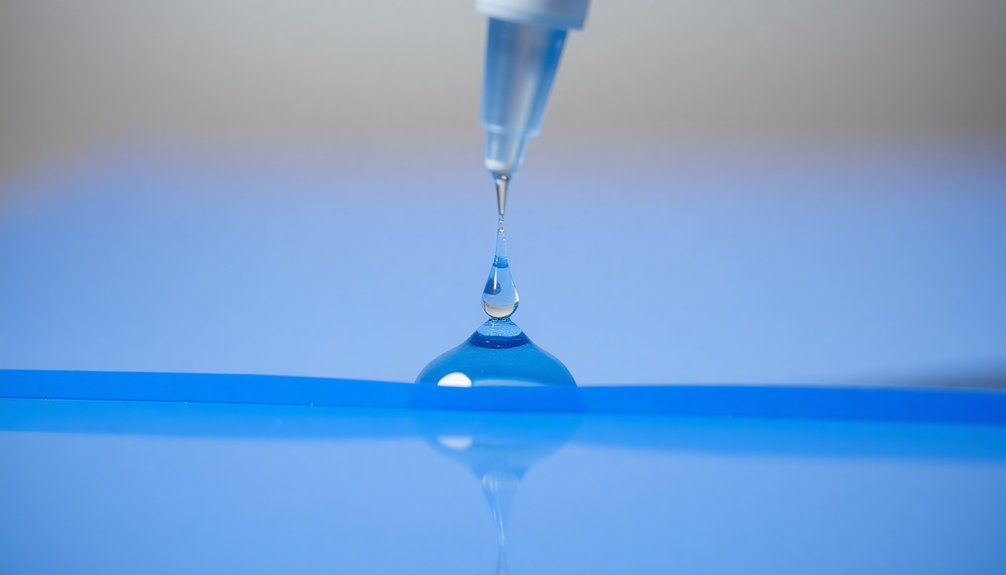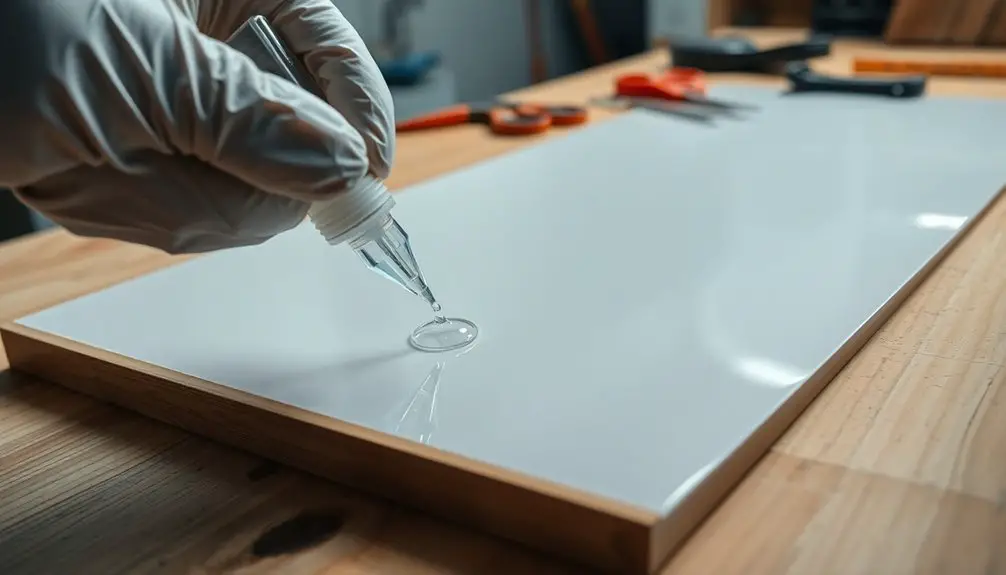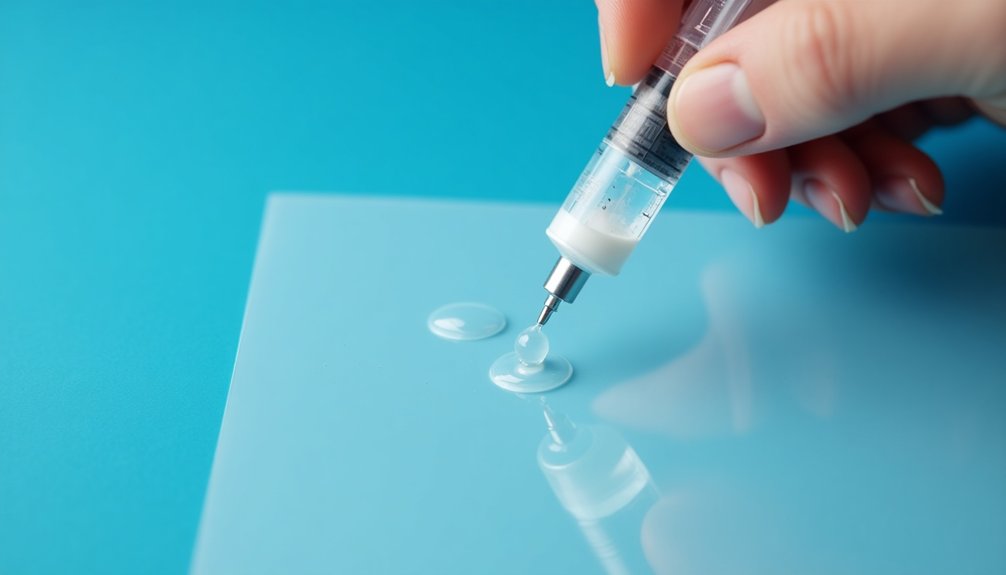Gluing polypropylene isn't straightforward due to its low surface energy, but you can achieve strong bonds with the right approach. Start by lightly sanding the surfaces to improve adhesion. Use specialty adhesives like Infinity Bond MMA or Forgeway's Purok VX90, designed specifically for low-energy plastics. Consider applying a primer like Permabond POP for better compatibility with cyanoacrylate glues. Follow the manufacturer's guidelines for curing time to ensure a strong bond. With these techniques, you'll enhance your chances of a successful adhesive bond. There's more to explore on optimizing your bonding process, so keep going!
Key Takeaways
- Use specialty adhesives specifically formulated for polypropylene, such as Infinity Bond MMA or Forgeway's Purok VX90, for effective bonding.
- Enhance adhesion by treating surfaces with flame or plasma to increase surface energy before applying adhesive.
- Lightly sand surfaces to improve mechanical interlocking and adhesion potential for better bond strength.
- Follow the adhesive manufacturer's guidelines for curing time to ensure optimal bond durability and strength.
- Clean any excess adhesive with acetone after curing for a neat finish and to avoid structural issues.
Understanding Polypropylene
When you think about versatile materials, polypropylene (PP) likely comes to mind. As one of the most widely produced low surface energy plastics, it boasts a surface energy of around 29 mJ/m², which makes adhesive bonding a challenge.
Despite this, polypropylene is celebrated for its strength, durability, and excellent chemical resistance, making it a top choice in applications ranging from packaging to automotive parts.
Polypropylene's versatility allows it to be molded into various forms including films, fibers, and components, which is why you'll find it in everyday items like containers and bins. Its high strength-to-weight ratio is particularly advantageous in the automotive industry, where lightweight materials enhance fuel efficiency.
To achieve a strong bond when working with polypropylene, you'll need a specialized polypropylene adhesive, as conventional adhesives often fail due to the material's low surface energy.
Understanding the different types of plastics and how they interact with bonding techniques is crucial for effective use. Utilizing a structural adhesive designed for bonding polypropylene can help you overcome these challenges and ensure a reliable connection in your projects.
Challenges in Bonding
Bonding polypropylene presents unique challenges due to its low surface energy of around 29 mJ/m². This low energy makes it difficult for most adhesives, which generally require a surface energy above 38 mJ/m², to form a strong bond. Additionally, using mechanical pretreatment methods like sanding or sandblasting often proves time-consuming and may not enhance adhesion effectively.
Heat generated during bonding processes can further compromise the structural integrity of polypropylene, leading to weakened bonds. To overcome these challenges, you may need to rely on specialty adhesives specifically formulated for low surface energy plastics. However, these adhesives can be limited in availability.
Surface preparation techniques like plasma or corona treatment can improve adhesive performance, but they come with their own set of challenges, such as high costs and variable effectiveness. Here's a quick overview of the challenges:
| Challenge | Description | Solution |
|---|---|---|
| Low Surface Energy | Difficult for standard adhesives to bond properly | Use specialty adhesives |
| Mechanical Pretreatment | Often ineffective and time-consuming | Explore alternative methods |
| Heat Sensitivity | Can weaken bonds during application | Control bonding temperature |
Understanding these challenges will help you navigate the complexities of bonding polypropylene.
Effective Bonding Methods

Utilizing effective bonding methods is crucial for overcoming the challenges associated with polypropylene. Due to its low surface energy, achieving a strong bond requires specialized techniques. One of the best adhesives for this purpose is Infinity Bond MMA, specifically formulated for low-energy surfaces. It simplifies the bonding process, often needing minimal surface treatment.
Before applying the adhesive, you might consider treating the surface to enhance adhesion. Techniques like flame or plasma treatment can increase surface energy, but they can be costly and variable in effectiveness.
Alternatively, applying a primer like Permabond POP can improve compatibility with cyanoacrylate adhesives on untreated surfaces.
For certain applications, especially where temperature resistance is vital, using a two-part adhesive can provide a robust solution. This method is particularly useful for bonding polypropylene in food containers, ensuring safety and durability.
If you're working in confined spaces, remember that plastic welding is another viable option, though it may be limited. By following these bonding methods, you can achieve effective and lasting results when working with polypropylene. In addition, using a plastic greenhouse with proper insulation and thermal mass can help maintain a stable environment for your projects, such as polyethylene greenhouses, which are cost-effective and UV resistant.
Choosing the Right Adhesive
Selecting the right adhesive for polypropylene is essential, given its low surface energy of around 29 mJ/m². Most common adhesives, with surface energy above 38 mJ/m², often fail to create effective bonds with polypropylene. To achieve strong bonds, you should consider specialty adhesives specifically designed for low surface energy plastics. Products like Forgeway's Purok VX90 and Infinity Bond MMA 500 are excellent choices for this purpose.
When bonding polypropylene, surface preparation can significantly enhance adhesive performance. Methods such as priming with compatible products or utilizing treatments like flame or plasma can help improve the adhesion of non-specialist adhesives.
However, it's crucial to remember that not all adhesives will perform equally well, even with surface preparation. Testing different adhesive options is vital to find the best fit for your specific application.
Consider factors like durability, cure speed, and strength during your selection process. If you're also working with polyethylene, keep in mind that its bonding requirements may differ. Additionally, using adhesives that are resistant to high temperatures can also contribute to a strong and durable bond with polypropylene.
Best Practices for Strong Bonds

Achieving strong bonds with polypropylene requires careful attention to best practices that enhance adhesion. Since polypropylene and polyethylene are difficult to bond, following these guidelines will help you achieve a good bond:
- Choose the right polypropylene glue: Opt for adhesives specifically designed for low surface energy plastics, like Infinity Bond MMA 500 or Permabond TA4600.
- Prepare the surface: Lightly sand the surfaces before applying adhesive to increase surface area and improve adhesion.
- Control the cure speed: Apply a small amount of adhesive on one surface, press firmly against the other, and use clamps if needed. Allow sufficient curing time as specified by the adhesive manufacturer—MMA 500 achieves a permanent bond in 24 hours.
- Avoid incompatible adhesives, like PVC glue on ABS, which can lead to weak joints and compromised structural integrity.
After the adhesive has cured, gently remove any excess glue with a cloth soaked in acetone to maintain a clean finish and avoid compromising the bond integrity.
Frequently Asked Questions
What Glue Works Best on Polypropylene?
To bond polypropylene effectively, you'll want to use adhesives specifically designed for low surface energy plastics. Products like Loctite Super Glue All Plastics or Permabond's TA4600 series work best for achieving strong, durable bonds.
How to Make Polypropylene Harder?
To make polypropylene harder, you can incorporate glass fibers during manufacturing, increase its molecular weight through polymerization, or use higher crystalline grades. Crosslinking and controlled cooling also enhance its hardness and durability significantly.
Does Gorilla Glue Bond Polypropylene?
Gorilla Glue doesn't bond well with polypropylene due to its low surface energy. You'll need to prepare the surface or use a specialized adhesive designed for low surface energy plastics for effective results.
Does JB Weld Bond Polypropylene?
JB Weld doesn't bond polypropylene effectively because of its low surface energy. You'll need specialized adhesives or significant surface preparation, like sanding, to increase adhesion chances, but even then, results aren't guaranteed.

